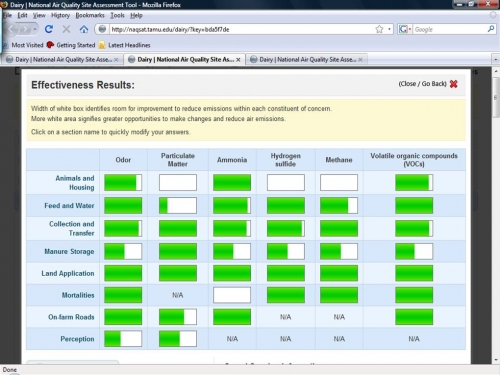New tool for assessing air emissions from livestock farms
The National Air Quality Site Assessment Tool helps livestock farmers evaluate the opportunities for reducing air emissions and odors associated with their operation.
The National Air Quality Site Assessment Tool (NAQSAT) is an online tool designed to evaluate the opportunities to reduce the air emissions and odors associated with livestock facilities and manure handling, storage and application. The tool, released in August 2010, is available for producers, their advisors and management team online. NAQSAT provides producers the opportunity to evaluate their current management practices and compare potential emissions and odor mitigation practices for their farm in the privacy of their own home or office. The tool provides valuable information for the producer while maintaining the confidentiality they may prefer.
NAQSAT can be used for swine, dairy, beef feed lots, broiler chicken, laying hen and turkey operations. The tool addresses eight management categories related to air emissions: animals and housing, feed and water, collection and transfer of manure, manure storage, land application, mortalities, on-farm roads and public perception.
Users of the tool are asked a series of questions under each management category. Based on the answers to previous questions, the tool determines what additional questions need to be answered. Only questions that pertain to the current user will be asked. Pop-up pictures assist in determining the relative rating to select where a visual evaluation will increase accuracy.
The picture below provides a copy of the NAQSAT report or Effectiveness Results page. Notice the effectiveness results do not contain quantitative numbers. The tool was designed to be user friendly void of any concern that it could be considered a regulatory tool.
 To interpret the Effectiveness Results page, the green area indicates how effectively current facilities and management practices are mitigating the emission of concern. The white area indicates the opportunity for improvement.For example, if the sample farm in the picture was concerned about methane emissions, the greatest opportunity for reducing those emissions would be in the “Animals and Housing” management category followed by “Manure Storage”since those two management categories have more white showing in the boxes under the column labeled “Methane”. The greatest opportunity for reducing odor is under “Manure Storage” and “Perception” since the other six management categories under “Odor” are either all green or almost all green. A totally green box does not indicate there are no emissions, it simply means there are limited opportunities for improvement for that emission in that management category.
To interpret the Effectiveness Results page, the green area indicates how effectively current facilities and management practices are mitigating the emission of concern. The white area indicates the opportunity for improvement.For example, if the sample farm in the picture was concerned about methane emissions, the greatest opportunity for reducing those emissions would be in the “Animals and Housing” management category followed by “Manure Storage”since those two management categories have more white showing in the boxes under the column labeled “Methane”. The greatest opportunity for reducing odor is under “Manure Storage” and “Perception” since the other six management categories under “Odor” are either all green or almost all green. A totally green box does not indicate there are no emissions, it simply means there are limited opportunities for improvement for that emission in that management category.
After entering information reflecting the farm’s current status users may save the session and run alternative scenarios for comparison of implementing new management schemes and/or emission mitigation practices. Mitigation practices sometimes result in trade-offs where the new practice reduces the emission of one constituent while at the same time increasing the emission of a second. Running multiple scenarios of NAQSAT identifies these trade-offs prior to the producer investing large sums in control practices that don’t fully meet their needs or goals.
The program may only be run from its host website (it does not download onto your computer). Each “saved”session of NAQSAT is stored under its own URL available only to the person or persons with knowledge of the URL address. Sessions remain saved on the host computer for 30 days. Users may return to the URL anytime within that time period to make changes or re-visit the results.
The tool results do not provide emissions data and/or regulatory guidance. It was developed for voluntary and educational purposes.All sessions on NAQSAT are confidential and available only to the user. There are no fees associated with accessing and using NAQSAT.



 Print
Print Email
Email